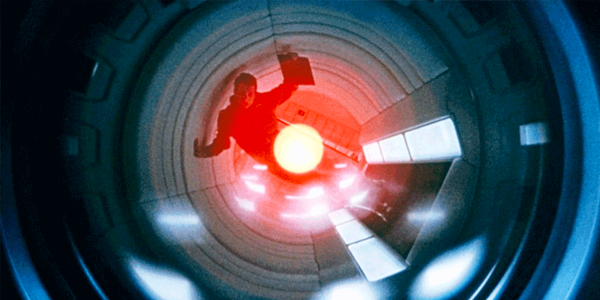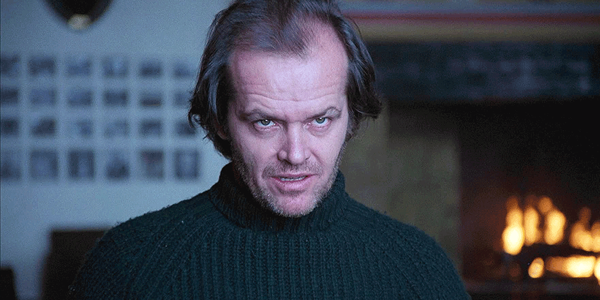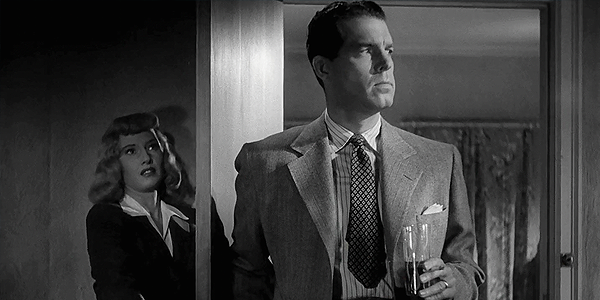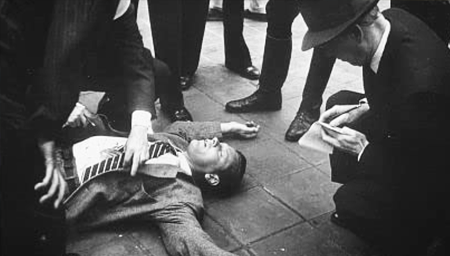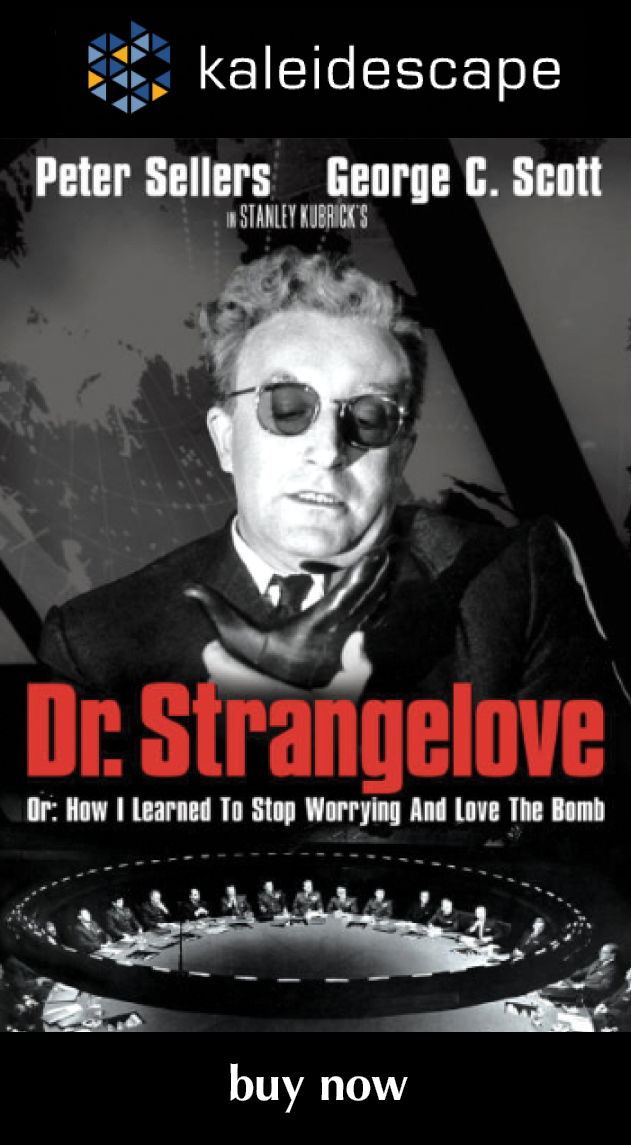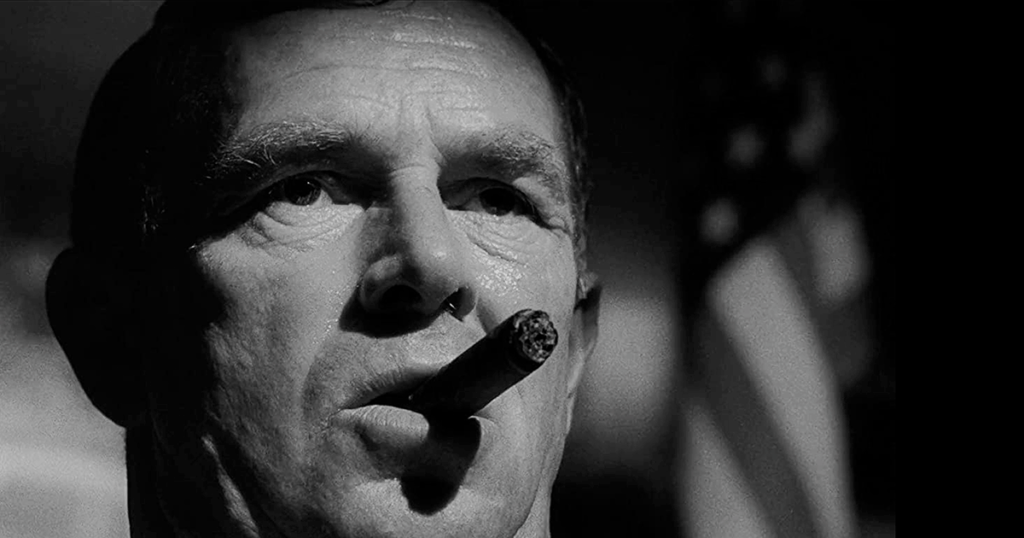
Dr. Strangelove and the Power of Blackness
Why This Isn’t a Review
I ultimately decided to not review this release of Strangelove because 4K HDR takes away as much as it brings to the experience, so while there’s no great harm in watching it that way, there’s no real benefit either.
One of the biggest problems is one common to many 4K upgrades of older films. Nobody has figured out how to accurately translate backdrops and matte paintings that looked convincing when run through a projector and shown on a big screen. Here, the opening painting of Burpleson Air Force Base and the later one of the Pentagon are so obvious that they pull you out of the film. Similarly, the model shots of the B-52, which were only borderline successful on film, look too clean and sterile and model-y now.
While someone could argue that the HDR increases the impact of the nuclear bomb blasts, I would have to counter that this isn’t an action or war film and that, since Kubrick relied on archival footage rather than effects shots, that’s not what he was after. Pumping the shots up that way is akin to adding cannon blasts to Beethoven’s “Ode to Joy”—which I’m sure has been done, but not by anybody who deserved to live afterward. A more accurate example might be someone deciding to improve the impact of the Scherzo in the Ninth by doubling all the orchestral lines with synthesizers. I suspect that would make the work more compelling for those listeners with duller nerve endings but it would be an egregious violation of Beethoven’s original intent and a travesty of his work. Sure, anyone’s free to reinterpret Beethoven—or Bach or Stravinsky or Mahler—but don’t pretend you’re presenting the original work. Leaning too heavily on HDR is like deciding the original compositions need an injection of testosterone.
And then there’s the kerfuffle over the aspect ratios. The best I can determine, Kubrick decided it would enhance the home video release of Strangelove by showing the frame ratios of the original footage, alternating between various ratios for the War Room, the Burpleson interiors, the bomber interior, and the documentary footage of the attack on Burpleson. Yes, this was him allowing for the Academy ratio of pre-HDTV home video and, yes, his similar tack with the release of The Shining was a disaster. But the point is that, with Strangelove, it worked, and I don’t get why this current release reverts back to 1:66:1.
But, again, this isn’t a review. It’s just an explanation of why I didn’t want to do a review.
—M.G.
ALSO ON CINELUXE
Strangelove is considered a classic comedy and an unequaled satire, but a recent re-viewing revealed that comedy and satire might not have been Kubrick’s ultimate aim here
by Michael Gaughn
December 25, 2020
I wasn’t going to review the latest release of Dr. Strangelove. After having basked in the 4K HDR editions of 2001 and The Shining, it didn’t feel right to underline that this newest upgrade isn’t all it could or should be. Reviews of older films should focus on the ones worth watching, not the ones to avoid. But, on a whim, I watched Strangelove again a few nights ago and experienced it in ways I never have before, and ultimately decided that, transfer quality be damned, it’s well worth encouraging others to go check it out.
Keep in mind, before we dive into this, that I’ve seen this movie countless times. I’ve studied various drafts of the screenplay and pored over every relevant comment from the cast and crew. I’ve even watched an archive print on a Moviola at the Library of Congress. But this last time around, the film, for whatever reason, revealed things that had always been hidden to me before.
The biggest revelation—and what will be the crux of my comments here—is that Strangelove is only superficially a comedy. At its heart, it’s a film noir—and, at the end of the day, might even represent the pinnacle of that genre.
For that conclusion to make sense, you have to be willing to roll with my definition of noir in “Who Killed Film Noir?”—that the crime element is just a pretext and that these movies are instead always about chumps—more specifically, male chumps—guys who think they know the score only to find they really don’t have a clue, only to then have everyone and everything conspire against them, usually with fatal results. If you accept that definition, then noir fits Strangelove as snugly as the mad doctor’s Rotwang glove.
Yes, the film is heavy on noir atmospherics—dark recesses, menacing shadows, closeups that make it look like the subject is being interrogated under hot lights, etc.—but dwelling on that kind of misses the point, because Strangelove pulls just as many stylistic elements from crime dramas, war films, horror films, psychological thrillers, documentaries, and newsreels. The one genre it doesn’t look anything like is comedy, and that is central to what I’m positing here.
Strangelove is really comedy by other means. Its laughs—which are many and legitimate—spring almost solely from the extreme gruesomeness of the situation, from a kind of squeamishness and disbelief that ultimately reinforces the dominance of the Death Drive over the Pleasure Principle, and that people will blindly follow through on the inherent logic of their institutions and devices—all the while believing they’re exercising intelligence and will—even if it will result in their own annihilation.
This movie is satire first and comedy second. And it’s stunning, on reflection, what a serious film it is, that it trumps all of the more sophomoric stuff that considers itself satire by diving down deep into the same disturbing roots and unblinking take on humanity that motivated Swift. This is satire with some real meat, with more than a little gristle, on its bones—definitely not for the SNL crowd.
It’s also stunning to realize what a leap it is beyond the mess of Lolita. You can sense Kubrick trying to recover his creative integrity after the rout of his previous film, where the material, the censors, and, most importantly, the narrative tradition all got the better of him. Knowing that the story is always the least interesting thing about a movie and something filmmakers tend to lean on as a crutch, he had tried to subvert the conventions by notoriously moving Humbert’s murder of Quilty to the beginning of the film—a huge miscalculation that only served to deflate the whole enterprise. He was way bolder with Strangelove, exposing the sheer contrivance of narrative by taking a clockwork-type suspense plot and twisting it around to serve ends no one would have thought it could ever possibly serve, and along the way exposing storytelling for what it mainly is: A manipulative mechanical device for efficiently getting you from Point A to Point Z, which in this case is the end of the world.
With Strangelove, Kubrick hit on the formula that would serve him well for the rest of his career of mimicking just enough genre conventions to entice and enthrall the groundlings and ensure the studio’s ROI, while having the movies actually function at levels that ultimately made hash of their seeming reasons to be. So Strangelove has just enough silly comedy and thriller elements to keep the masses in their seats but continuously moves up a creative chain, subsuming the more rudimentary elements along the way, until it ultimately arrives at noir—but noir in a way no one had ever seen it before.
To put it another way: Having been too conservative with Lolita, Kubrick decided to completely trust his gut with Strangelove, and his gut told him to make a suspense thriller that was, incongruously, a comedy, but was actually, ultimately, a film noir. But that’s not the genius part. The genius part is that he made all three dovetail so seamlessly that the transitions from the cheap seats on up don’t feel so much perverse as inevitable.
Watch Strangelove through the lens of noir—noir stripped of most of its genre clichés in order to expose its white-hot core—and it becomes a different, much more nuanced and brilliant film. Noir wasn’t new to Kubrick. Killer’s Kiss and The Killing are both overt takes on the genre, the latter unapologetically feeding from John Huston’s The Asphalt Jungle. (Huston’s Treasure of the Sierra Madre was another Kubrick favorite.)
But there’s another dimension to this that also deepens the experience of the film and that hadn’t been obvious to me until this most recent viewing, when I realized how heavily Kubrick tapped into his photo-journalistic beginnings. Fresh out of high school, he had been the youngest staff photographer ever at Look magazine, and it was his experiences there that supplied the subject matter for his early documentary shorts and for Killer’s Kiss, which look like photo essays come to life.
He returns to those formative experiences and that style in Strangelove, with much of the film resembling his magazine work, most obviously in the faux documentary attack on Burpleson Air Force Base, but far more subtly and strikingly in the War Room. He went there mainly to underline that no matter how surreal, irrational, and immature a lot of the behaviors and actions are in the film, they have very real consequences.
(But there are more layers to it than that, because Kubrick hired the controversial tabloid photographer Weegee—whose body of work essentially transformed sordid reality into noir—as his on-set photographer. That led to Peter Sellers, fascinated by Weegee’s edgy hardboiled patois, using his voice as the inspiration for Strangelove.
(And to complete my digression, It should be mentioned that Kubrick got to know fashion-turned-art photographer Diane Arbus well during his Look years, and later referenced her work explicitly in The Shining—which raises the point that his films are far more autobiographical and personal than the cliché take on him as cold, detached, clinical would allow.)
Rather than give a complete recitation of all the ways noir permeates and defines the film, I’ll just highlight a couple of key moments and you can work backward from there. Just before Sterling Hayden’s General Ripper trudges off to the bathroom to commit suicide, Kubrick holds on an uncomfortably close shot of his face, rimmed so tightly with shadows that it already resembles a death mask. As Sellers’ Group Captain Mandrake sits next to Ripper, prattling on about the recall code, Kubrick just stays on the general. And although there are no obvious changes in Ripper’s expression, you can tell he’s realizing the full enormity of what he’s done right before disappearing completely into madness. But this is done with amazing restraint, with Kubrick resisting the temptation to go to the kind of crazy stare he would later cultivate with Jack in The Shining and Pyle in Full Metal Jacket. You just sense the descent happening—almost imperceptibly, but undeniably. It might be the ultimate film noir moment.
This shot could have been Hayden as Johnny Clay in The Killing or as Dix Handley in The Asphalt Jungle—it wouldn’t have looked out of place cut into either of those films. And Kubrick uses that commonality to create a through-line that traverses all of noir, pointing inevitably to Strangelove as its culmination.
Comedies usually rely on master shots instead of closeups, but Kubrick comes in similarly close on Strangelove to emphasize how much he’s caught up in, and boxed in by, his own calculations and obsessions, his own form of culturally sanctioned insanity. You’re placed just inches from a madman, and it’s as frightening as it is funny.
The most outrageous noir before Strangelove was Robert Aldrich’s beyond cheeky Kiss Me Deadly, which took the hugely popular Mike Hammer character and exposed him for the clueless goon he was. This isn’t the place to go into it, but Strangelove seems to riff on Deadly, seems to devour and digest and regurgitate it, taking the cocksure bumbling of an L.A. detective and projecting it onto the whole world, making chumps of us all.
Watching Strangelove today is hardly just an exercise in either nostalgia or film appreciation, something only tangentially relevant to our present. The basics of human nature haven’t changed since 1964—if anything, the blind, primal aspects have only become emboldened as the machines have taken over and we’ve become free to play. It’s not like the methods of the West have changed all that much either—except that they’ve been so successfully exploited that a YouTube video from Melbourne looks identical to a YouTube video from Bhopal looks identical to one from Des Moines. And it’s not like the world doesn’t continue to bristle with nuclear arms. And it’s not like it’s become impossible for a madman to ascend to the highest levels of power.
Noir is who we are when we have the guts to face ourselves squarely in the mirror. And it says a lot that it’s been more than five decades since the last time any one’s bothered to take a good look.
Michael Gaughn—The Absolute Sound, The Perfect Vision, Wideband, Stereo Review, Sound & Vision, The Rayva Roundtable, marketing, product design, some theater designs, a couple TV shows, some commercials, and now this.
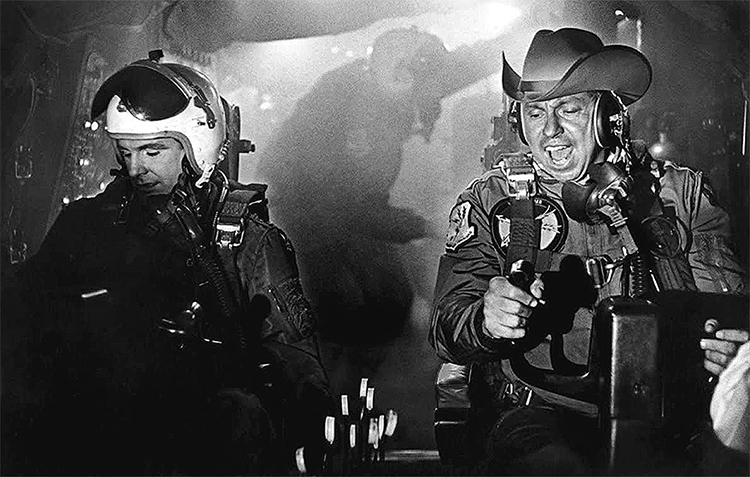
Where in Hell is Major Kong?
Another thing that jumped out at me watching Strangelove this time around was the missile attack on the B-52, which is for the most part an extremely believable documentary-style scene (especially for 1964) with nothing remotely funny about it. Of course, I’ve noticed this scene before—it’s so compelling it’s hard to ignore—but I realized this time how unique it is, since the list of comedies that can afford to go full-bore dramatic for this amount of screen time without losing their momentum or completely throwing the audience is so short it probably doesn’t exist. One of Kubrick’s most brilliant set pieces, it convincingly places you inside the plane with the crew as they fight for their lives, so you identify with their efforts and then root for them to complete their mission—which has to create extremely conflicted emotions in all but the most jaded. The crew’s ability to overcome is the thing seals the fate of the world. The scene is also worth savoring for the way its chaotic handheld camera goes from documentary to abstract, turning it into a mini art film. Most movie scenes are too stage-bound or veer too close to radio—even today. This one is pure cinema.
—M.G.
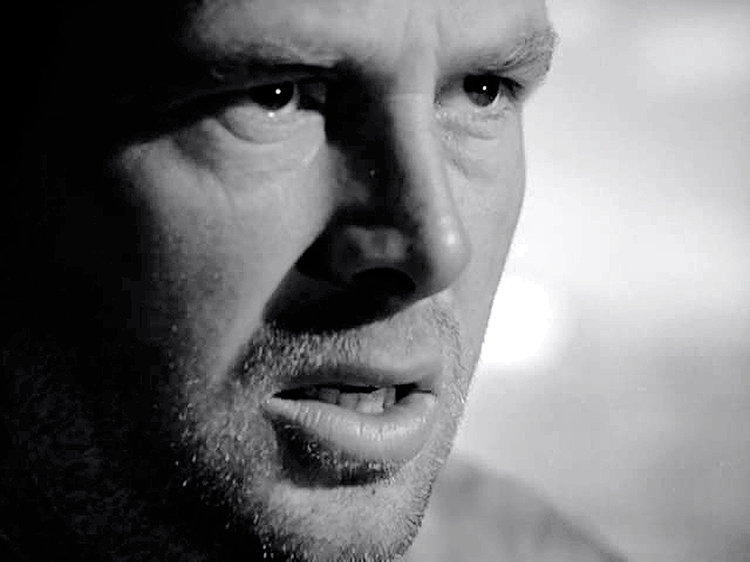
Dix Handley
© 2025 Cineluxe LLC


